
Drysdallite is a rare and intriguing mineral that has captured the interest of geologists and mineral enthusiasts alike. But what exactly makes this mineral so special? Drysdallite is primarily composed of molybdenum disulfide, giving it a unique metallic luster and a striking appearance. Found mainly in Zambia, this mineral is named after Arthur Drysdall, a notable geologist. Its rarity and distinctive properties make it a subject of fascination. In this blog post, we will uncover 20 fascinating facts about Drysdallite, from its chemical composition to its geological significance. Get ready to dive into the world of this captivating mineral!
Key Takeaways:
- Drysdallite, a rare mineral named after A.R. Drysdall, was discovered in Zambia in 1968. It has a metallic luster, primarily composed of molybdenum and sulfur, and is used as a solid lubricant and studied for its unique properties.
- Drysdallite, also known as "molybdenite," has a fascinating geological occurrence in Africa and is valued by mineral collectors. While not highly toxic, it requires careful handling, and its mining activities should be conducted responsibly to minimize environmental impact.
What is Drysdallite?
Drysdallite is a rare mineral that has intrigued geologists and mineral enthusiasts alike. Named after its discoverer, this mineral has unique properties and characteristics that set it apart from others. Let's dive into some fascinating facts about Drysdallite.
Discovery and Naming
The story of Drysdallite's discovery and naming is quite interesting. Here are some key points:
- Named After: Drysdallite is named in honor of A.R. Drysdall, a geologist who made significant contributions to the field.
- First Found: This mineral was first identified in Zambia, a country known for its rich mineral deposits.
- Year of Discovery: It was officially recognized as a new mineral species in 1968.
Physical Characteristics
Drysdallite has some unique physical properties that make it stand out. Here are a few:
- Color: Typically, Drysdallite appears in shades of gray to black.
- Luster: It has a metallic luster, giving it a shiny, reflective surface.
- Hardness: On the Mohs scale, Drysdallite ranks around 2.5, making it relatively soft.
- Crystal System: It belongs to the hexagonal crystal system, which influences its shape and structure.
Chemical Composition
Understanding the chemical makeup of Drysdallite provides insight into its formation and properties.
- Primary Elements: Drysdallite is primarily composed of molybdenum and sulfur.
- Chemical Formula: Its chemical formula is MoS2, indicating it contains one molybdenum atom for every two sulfur atoms.
- Formation: This mineral typically forms in hydrothermal veins, where hot, mineral-rich water flows through cracks in rocks.
Geological Occurrence
Drysdallite's geological context is as fascinating as its physical and chemical properties.
- Primary Locations: Besides Zambia, Drysdallite has been found in other parts of Africa, including Namibia and the Democratic Republic of Congo.
- Associated Minerals: It often occurs alongside other sulfide minerals like pyrite and chalcopyrite.
- Mining: While not a primary target for mining, Drysdallite can be found in mines extracting other valuable minerals.
Uses and Applications
Though not as widely used as some other minerals, Drysdallite has its own set of applications.
- Lubricant: Due to its layered structure, Drysdallite can act as a solid lubricant, reducing friction between surfaces.
- Research: Scientists study Drysdallite to understand more about molybdenum's properties and potential uses.
- Collectors: Mineral collectors value Drysdallite for its rarity and unique characteristics.
Environmental and Health Aspects
Like many minerals, Drysdallite has environmental and health considerations.
- Toxicity: While not highly toxic, handling Drysdallite with care is advised to avoid inhaling dust particles.
- Environmental Impact: Mining activities that extract Drysdallite can impact local ecosystems, necessitating responsible practices.
Fun Facts
Here are some lighter, fun facts about Drysdallite that you might find intriguing.
- Nicknames: Sometimes referred to as "molybdenite" due to its molybdenum content.
- Trivia: Drysdallite's metallic luster and unique properties make it a popular subject in geology classes and mineral exhibitions.
Final Thoughts on Drysdallite
Drysdallite, a rare mineral, holds a unique place in geology. Found primarily in Zambia, this mineral is known for its striking metallic luster and complex chemical composition. Its rarity makes it a subject of fascination for mineralogists and collectors alike. Understanding drysdallite's properties helps scientists learn more about the Earth's geological processes. Its discovery has also sparked interest in mining and extraction techniques, given its potential industrial applications. While not as well-known as other minerals, drysdallite's distinct characteristics make it a valuable addition to the world of mineralogy. Whether you're a seasoned geologist or just curious about the natural world, drysdallite offers a glimpse into the complexities of our planet's makeup. Keep an eye out for this intriguing mineral; you never know where it might turn up next!
Frequently Asked Questions
Was this page helpful?
Our commitment to delivering trustworthy and engaging content is at the heart of what we do. Each fact on our site is contributed by real users like you, bringing a wealth of diverse insights and information. To ensure the highest standards of accuracy and reliability, our dedicated editors meticulously review each submission. This process guarantees that the facts we share are not only fascinating but also credible. Trust in our commitment to quality and authenticity as you explore and learn with us.
